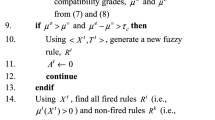Abstract
In this paper, the problem of learning in big data is considered. To solve this problem, a new algorithm is proposed as the combination of two important evolving and stable intelligent algorithms: the sequential adaptive fuzzy inference system (SAFIS), and stable gradient descent algorithm (SGD). The modified sequential adaptive fuzzy inference system (MSAFIS) is the SAFIS with the difference that the SGD is used instead of the Kalman filter for the updating of parameters. The SGD improves the Kalman filter, because it first obtains a better learning in big data. The effectiveness of the introduced method is verified by two experiments.








Similar content being viewed by others
References
Ahn CK (2012) An error passivation approach to filtering for switched neural networks with noise disturbance. Neural Comput Appl 21(5):853–861
Ahn CK (2014) A new solution to the induced l\(\infty \) finite impulse response filtering problem based on two matrix inequalities. Int J Control 87(2):404–409
Ahn CK, Lim MT (2013) Model predictive stabilizer for T-S fuzzy recurrent multilayer neural network models with general terminal weighting matrix. Neural Comput Appl 23(Suppl 1):S271–S277
Angelov P, Filev D, Kasabov N (2010) Evolving intelligent systems—methodology and applications. Wiley, New York
Bordignon F, Gomide F (2014) Uninorm based evolving neural networks and approximation capabilities. Neurocomputing 127:13–20
Bouchachia A (2008) Incremental Learning. Encyclopedia of Data Warehousing and Mining, pp 1006–1012
Bouchachia A (2014) Online dataprocessing. Neurocomputing 126:116–117
Bouchachia A, Lena A, Vanaret C (2014) Online and interactive self-adaptive learning of user profile using incremental evolutionary algorithms. Evol Syst 5:143–157
Bouchachia A, Vanaret C (2014) GT2FC: an online growing interval type-2 self-learning fuzzy classifier. IEEE Trans Fuzzy Syst 22(4):999–1018
Gama J (2010) Knowledge discovery from data streams. Chapman & Hall/CRC, Boca Raton
Gama J, Zliobaite I, Bifet A, Pechenizkiy M, Bouchachia A (2014) A survey on concept drift adaptation. ACM Comput Surv 46(4):44
Garcia-Cuesta E, Iglesias JA (2012) User modeling: Through statistical analysis and subspace learning. Expert Syst Appl 39:5243–5250
Gomide F, Lughofer E (2014) Recent advances on evolving intelligent systems and applications. Evolv Syst 5:217–218
Hartert L, Sayed-Mouchaweh M (2014) Dynamic supervised classification method for online monitoring in non-stationary environments. Neurocomputing 126:118–131
Huang G-B, Saratchandran P, Sundararajan N (2004) An efficient sequential learning algorithm for growing and pruning RBF (GAP-RBF) networks. IEEE Trans Syst Man Cybern Part B Cybern 34(6):2284–2292
Iglesias JA, Tiemblo A, Ledezma A, Sanchis A (2015) Web news mining in an evolving framework. Inf Fusion. doi:10.1016/j.inffus.2015.07.004
Iglesias JA, Ledezma A, Sanchis A (2014) Evolving classification of UNIX users’ behaviors. Evolv Syst 5:231–238
Iglesias JA, Skrjanc I (2014) Applications, results and future direction. Evolv Syst 5:1–2
Kasabov N (2007) Evolving connectionist systems: the knowledge engineering approach, 2nd edn. Springer Verlag, London
Klancar G, Skrjanc I (2015) Evolving principal component clustering with a low run-timecomplexity for LRF data map**. Appl Soft Comput 35:349–358
Lughofer E (2011) Evolving fuzzy systems—methodologies, advanced concepts and applications. Springer, Berlin, Heidelberg
Lughofer E, Cernuda C, Kindermann S, Pratama M (2015) Generalized smart evolving fuzzy systems. Evolv Syst. doi:10.1007/s12530-015-9132-6
Lughofer E, Sayed-Mouchaweh M (2015) Autonomous data stream clustering implementing split-and-merge concepts—towards a plug-and-play approach. Inf Sci 304:54–79
Lughofer E, Sayed-Mouchaweh M (2015) Adaptive and on-line learning in non-stationary environments. Evol Syst 6:75–77
Marques Silva A, Caminhas W, Lemos A, Gomide F (2014) A fast learning algorithm for evolving neo-fuzzy neuron. Appl Soft Comput 14:194–209
Ordoñez FJ, Iglesias JA, de Toledo P, Ledezma A, Sanchis A (2013) Online activity recognition using evolving classifiers. Expert Syst Appl 40:1248–1255
Perez-Cruz JH, Rubio JJ, Pacheco J, Soriano E (2014) State estimation in MIMO nonlinear systems subject to unknown deadzones using recurrent neural networks. Neural Comput Appl 25(3–4):693–701
Perez-Cruz JH, Rubio JJ, Encinas R, Balcazar R (2014) Singularity-free neural control for the exponential trajectory tracking in multiple-input uncertain systems with unknown deadzone nonlinearities. The Scientific World Journal 2014:1–10
Pratama M, Anavatti SG, Er MJ, Lughofer ED (2015) pClass: an effective classifier for streaming examples. IEEE Trans Fuzzy Syst 23(2):369–386
Precup R-E, Sabau M-C, Petriu EM (2015) Nature-inspired optimal tuning of input membership functions ofTakagi-Sugeno-Kang fuzzy models for Anti-lock Braking Systems. Appl Soft Comput 27:575–589
Rong HJ, Sundararajan N, Huang GB, Saratchandran P (2006) Sequential adaptive fuzzy inference system (SAFIS) for nonlinear system identification and prediction. Fuzzy Sets Syst 157(9):1260–1275
Rubio JJ, Angelov P, Pacheco J (2011) An uniformly stable backpropagation algorithm to train a feedforward neural network. IEEE Trans Neural Netw 22(3):356–366
Rubio JJ, Ortiz F, Mariaca CR, Tovar JC (2013) A method for online pattern recognition for abnormal eye movements. Neural Comput Appl 22(3–4):597–605
Rubio JJ, Vazquez DM, Mujica-Vargas D (2013) Acquisition system and approximation of brain signals. IET Sci Meas Technol 7(4):232–239
Sayed-Mouchaweh M, Lughofer E (2015) Decentralized fault diagnosis approach without a global model for fault diagnosis of discrete event systems. Int J Control. doi:10.1080/00207179.2015.1039594
Sayed-Mouchaweh M, Lughofer E (2012) Learning in non-stationary environments: methods and applications. Springer, New York
Torres C, Rubio JJ, Aguilar-Ibañez C, Perez-Cruz JH (2014) Stable optimal control applied to a cylindrical robotic arm. Neural Comput Appl 24(3–4):937–944
Zdesar A, Dovzan D, Skrjanc I (2014) Self-tuning of 2 DOF control based on evolving fuzzy model. Appl Soft Comput 19:403–418
Acknowledgments
The authors are grateful to the editors and the reviewers for their valuable comments. The first author thanks the Secretaría de Investigación y Posgrado, Comisión de Operación y Fomento de Actividades Académicas, and Consejo Nacional de Ciencia y Tecnología for their help in this research.
Author information
Authors and Affiliations
Corresponding author
Ethics declarations
Conflict of interest
The authors declare that they have no conflict of interest.
Additional information
Communicated by V. Loia.
Rights and permissions
About this article
Cite this article
de Jesús Rubio, J., Bouchachia, A. MSAFIS: an evolving fuzzy inference system. Soft Comput 21, 2357–2366 (2017). https://doi.org/10.1007/s00500-015-1946-4
Published:
Issue Date:
DOI: https://doi.org/10.1007/s00500-015-1946-4




